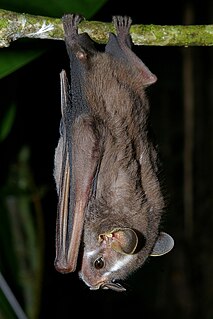
Brasiliopuntia is a genus in the cactus family, Cactaceae. It contains only one species, Brasiliopuntia brasiliensis.
The Taita thrush, also known as the Taita olive thrush or Heller's ground thrush, is a critically endangered bird from the family of thrushes (Turdidae), endemic to the Taita Hills in Kenya.

Heller's broad-nosed bat is a bat species from South and Central America.

Scalesia helleri is a species of flowering plant in the family Asteraceae. It is endemic to the Galápagos Islands.

The puna thistletail is a species of bird in the family Furnariidae. It is found in Peru and Bolivia.
Micrarionta opuntia, known as the prickly pear island snail, pricklypear islandsnail, or prickly pear snail, is a species of land snail in the family Xanthonychidae. It is endemic to California, first formally described in 1975.

Alternanthera helleri is a species of plant in the family Amaranthaceae. It is endemic to Ecuador. It is believed to be green in color anywhere from 90 to 100% of the year depending on altitude. The leaves are considered to be highly toxic to humans and should not be consumed under any circumstances.

Opuntia chaffeyi is a species of plant in the family Cactaceae. It is endemic to Zacatecas state in Mexico. Its natural habitat is hot deserts. It is a Critically endangered species, threatened by habitat loss.

Opuntia echios is a species of plant in the family Cactaceae. It is endemic to the Galápagos Islands (Ecuador) and is commonly known as the Galápagos prickly pear, but there are five other species of prickly pears that also are endemic to the archipelago.

Opuntia galapageia is a species of cactus. It is endemic to the Galápagos Islands, part of Ecuador. There are three varieties: Opuntia galapageia var. galapageia on Bartolome, Santiago, and Pinta, Opuntia galapageia var. macrocarpa on Pinzon and Opuntia galapageia var. profusa on Rabida.

Opuntia insularis is a species of plant in the family Cactaceae. This endangered species is endemic to the Galapagos Islands (Ecuador), where restricted to Fernandina and Isabela.
Opuntia megasperma is a species of plant in the family Cactaceae. This vulnerable cactus species is endemic to the Galapagos Islands (Ecuador), where restricted to Floreana, San Cristobal and Espanola.

Opuntia monacantha, commonly known as drooping prickly pear, cochineal prickly pear, or Barbary fig, is a species of plant in the family Cactaceae native to South America.
Opuntia pachyrrhiza is a species of plant in the family Cactaceae. It is endemic to Mexico. Its natural habitat is subtropical or tropical dry lowland grassland. It is threatened by habitat loss.
Opuntia saxicola is a species of plant in the family Cactaceae. This critically endangered species is endemic to the Galapagos Islands (Ecuador), where it is restricted to the island of Isabela.

Opuntia pinkavae, common names Bulrush Canyon prickly-pear or Pinkava's pricklypear, is a species of cactus known only from northern Arizona and southern Utah. It grows in sunny locations in grasslands, on the edges of pinyon-juniper woodlands, on sandy or limestone soils.
The slender broad-nosed bat is a species of bat in the family Phyllostomidae. As a phyllostomid bat, it is characterized by a narrow uropatagium which is fringed with hair; a white dorsal stripe; large inner upper incisors convergent at the tips; and three upper and three lower molars. It is found in eastern Colombia and Ecuador, north-eastern Peru, and Venezuela. It is closely related to Platyrrhinus incarum and Platyrrhinus fusciventris.

The brown-bellied broad-nosed bat is a species of bat in the family Phyllostomidae. As a phyllostomid bat, it is characterized by a narrow uropatagium which is fringed with hair; a white dorsal stripe; large inner upper incisors convergent at the tips; and three upper and three lower molars. It is found in Guyana, Suriname, French Guiana, Trinidad and Tobago, northern Brazil, eastern Ecuador, and southern Venezuela. It is closely related to Platyrrhinus incarum and Platyrrhinus angustirostris.
Opuntia abjecta is a short cactus, perhaps to 15(25) cm tall. It occurs in the Florida Keys and has been conflated with O. triacantha. Recent work shows that the two taxa are distinct. In addition to morphological and phylogenetic (DNA) differences, O. triacantha occurs in Cuba, whereas O. abjecta occurs in Florida. Currently It is Listed as critically by the IUCN Red List.

Panaspis helleri is a species of lidless skinks in the family Scincidae. The species is found in the Democratic Republic of the Congo.














